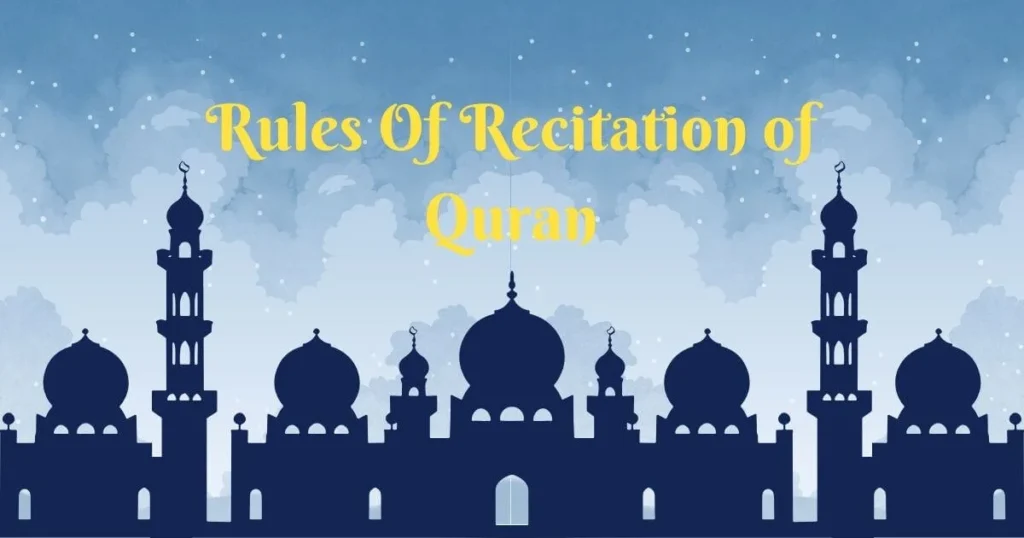
Rules Of Recitation of Quran :
Reciting the Holy Quran is one thing, but reciting it correctly is quite another. You might not be performing this as correctly if you are unfamiliar with the fundamentals of recitation. Thus, do you recognise the signs and symbols that appear over some words? Their significance, intent, and meaning? Understanding and following the Quran’s recitation guidelines on pauses, stops, starts, and cut-offs is necessary if you wish to learn how to recite the verses correctly. As a result, Qirat Quran Online presents to you today the fundamental and significant guidelines for reciting the Quran.
Basic Rules Of Recitation Of Quran
Let us begin with the fundamental guidelines for reciting the Quran. Many individuals are not familiar with the fundamental signs and symbols found in the Quran. So, these are the fundamental guidelines and symbols for Quran recitation that you all need to be aware of.
1) o– The Conclusion of Verse – Waqf e Taam
The Waqf e Lazim symbol indicates that you should now stop reading. The word Lazim literally translates as “to do at all costs,” or “imperative.” It is crucial to pause here since failing to do so will change the meaning of the statement as a whole.
2) مـ – The Compulsory Stop – Waqf e Lazim
The symbol for Waqf e Lazim indicates that you should stop reading now. The direct translation of the term Lazim is imperative, or to do at all costs. This is a crucial place to pause because if you don’t, the sentence’s meaning will change completely.
3) ط – The Absolute Pause – Waqf e Mutlaq
This stop sign will alert the reciter when it’s time to pause during the recitation. As soon as you see this symbol, you must inhale and stop for a brief period of time. It is imperative that you stop reading at this moment because doing so will make the process of reading easier for you.
4) ج – The Permissible Stop – Waqf e Jaaiz
This sign alludes to the resolution of the issue raised in the Ayah’s fragment. Thus, quit right away when you get to this point. However, you are mistaken if you believe it to be required. However, it is significant because, by pausing, you can quickly grasp the significance covered in the preceding Ayat.
5) ز – Continue Reading – Waqf e Mujawwaz
This Waqf e Majuwwaz symbol indicates that the reciter should continue reciting the Quran without pausing. Take note that stopping there is not prohibited either.
6) ص – The Licensed Pause – Waqf e Murakh-Khas
You ought to wait for this symbol if you’re tired out and want to take a break before continuing. When you’re tired, you can take a breather and a rest because of this sign. You should understand that you can only take a break when you’re truly tired. If not, continue reciting.
7) صلي – Preference for Continuation – Al-Wasl Awlaa
The reciting of this Quran is one of the most significant rules. Because there is no requirement to cease, this rule permits the Quranic recital to continue.
8) ق – Better not to Stop – Qeela ‘Alayhil-Waqf
This symbol means to continue reciting without stopping. However, there are a variety of viewpoints; some believe they should stop, while others disagree.
9) صل – The Permissible Pause – Qad Yusal
Although you should stop at this point, this symbol will indicate that you are allowed to continue the recitation.
10) ف – The Anticipation Mark – Qif
Even if you, the reciter, don’t think a stop sign is necessary, make sure you look to the top of the sign before continuing.
11) س – The Silence Symbol – Saktah
The reader should stop right away to look at the sign. However, be careful not to breathe before continuing to recite the Quran.
12) وقفتہ – The Long Pause – Waqfah
This symbol displays a lengthier pause than Saktah, similar to Saktah. Since this sign bears resemblance to Saktah, you won’t need to hold your breath during this pause.
13) لا – No Need of Stopping – Laa
There is no requirement to pause or stop reciting the verses at the appearance of this sign. As if the meaning of the verses of the Quran would be altered if you stopped when this symbol appeared. You can stop reciting if it is utilized with the Circle Mark of Conclusion at the end of the Ayah.
14) ك – Similar Meaning as Previous Sign – Kadhaalik
The activity implied by the sign Laa is also implied by this symbol.
15) ∴ – The Embracing Stop – Mu’anaqah
You won’t see this indication too often if you recite the Holy Quran. This sign will appear in a few verses, as stated in ayat 2 of Al-Baqarah:
ذَٰلِكَ الْكِتَابُ لَا رَيْبَ ۛ فِيهِ ۛ هُدًى لِّلْمُتَّقِينَ”
“This is the Book about which there is no doubt, a guidance for those conscious of Allah”
This symbol will appear several times in the same verse, as the verse given above makes clear. Either of the provided triplets should be the reciter’s stopping point.
16) وقف النبی – The Pause of Prophet PBUH – Waqf-un-Nabi
When you witness this symbol “وقف النبی”, you should stop there and take a pause, as these are the exact points where the Holy Prophet PBUH stopped and paused during the Quran recitation.
17) وقف غفران – The Sign of Supplication – Waqf e Ghufraan
This symbol means that the reciter needs to stop right away and offer up a prayer to Allah.
18) وقف منزل – The Pause Sign of Jibrael A.S – Waqf e Manzil
When this sign comes, as a reciter, you should take a pause at that point as well.
Conclusion
Every symbol and sign has its own importance. It is our responsibility as devout Muslims to recite the Holy Quran in accordance with these guidelines.
Share on >>
